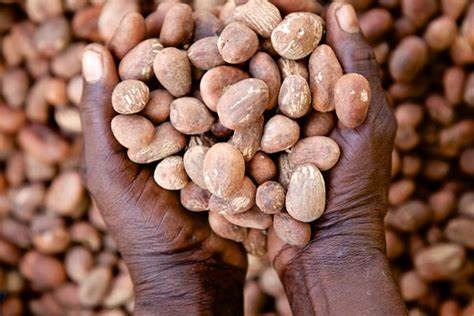The Sustainable Journey of Shea: From Harvesting to Empowerment
Explore the sustainable journey of shea, from harvesting to empowerment. Discover how traditional agricultural practices blend seamlessly with modern financial inclusion strategies to empower farmers and ensure the longevity of the shea industry.
Kay Codjoe
3/7/20242 min read


Step 1: Shea Nut Harvesting
Local farmers and collectors meticulously gather ripe shea fruits (nuts) during the fruiting season, typically spanning May to June, ensuring maximum readiness.
Step 2: Shea Nut Collection and Transportation
Gathered shea nuts begin their journey from collection points to designated processing centers or buying stations, facilitated by local traders or specialized transportation companies for efficient movement.
Step 3: Shea Nut Sorting and Cleaning
At processing centers, damaged, unripe, or decayed nuts are meticulously sorted out to refine quality. A thorough cleaning process follows, expelling dirt, leaves, and impurities.
Step 4: Shea Nut Drying
Cleaned shea nuts are methodically spread under the sun to naturally dry, minimizing moisture content and preserving quality.
Step 5: Shea Nut Cracking
Dried shea nuts are carefully cracked open to extract shea kernels, often with the expertise of local women and traditional tools.
Step 6: Shea Kernel Roasting
Extracted shea kernels undergo roasting in large drums or ovens, enhancing flavor and aroma, adding value to the final product.
Step 7: Shea Kernel Grinding
Roasted shea kernels are meticulously ground into a paste, using traditional grinding stones or modern mechanical mills, forming shea paste for extraction.
Step 8: Shea Butter Extraction
Shea paste is mechanically pressed to separate shea butter from solids, yielding crude shea butter.
Step 9: Shea Butter Refining
Crude shea butter undergoes refining processes like filtering, heating, and centrifugation to enhance purity and achieve premium quality.
Step 10: Packaging and Distribution
Refined shea butter is meticulously packaged for distribution, meeting diverse market requirements and ensuring quality preservation.
Step 11: Shea-Based Product Manufacturing
Shea butter is a key ingredient in skincare, cosmetic, and food products, crafted into various items such as lotions, creams, soaps, and edibles in separate facilities.
Step 12: Marketing and Sales
Shea-based products are marketed and sold through diverse channels, including local markets, online platforms, retail outlets, and global exports, ensuring accessibility to consumers worldwide.
Step 13: Bankable Deposit Transformation
Farmers leverage their shea-based products to access financial services, exploring opportunities such as bankable deposits to secure funds and foster growth.
Step 14: Financial Inclusion and Growth Access to financial services empowers farmers to utilize their deposits for loans and credit lines, facilitating growth and economic stability.
Step 15: Interest Accrual and Expansion
Accrued interest on deposits provides additional economic benefits, contributing to the expansion of farming operations and community development.
Step 16: Withdrawal or Renewal
At maturity, farmers have the choice to withdraw funds or renew deposits, directing their financial journey according to their needs and aspirations.
Step 17: Community Empowerment and Sustainability
Success stories of farmers thriving through bankable deposits inspire and unite the community, fostering sustainability and long-term growth in the shea industry.
This seamless integration of traditional agricultural practices with modern financial inclusion strategies paves the way for a sustainable future, empowering farmers and ensuring the prosperity of the shea industry and local economies alike.
Join us as we explore the Sheallo difference and discover how you can be part of a more sustainable Shea industry. Together, we can make a positive impact on communities, the environment, and the future of Shea production. Let's work towards a brighter and more ethical tomorrow with Sheallo.
Subscribe
Stay connected with Sheallo for the latest updates, industry insights, and exclusive offers! Subscribe now to join our community committed to sustainable sourcing and innovative agritech solutions.

Address: 9th Avenue Square, Abdul Diouf Street, Ridge 00233, Greater Accra Region, Ghana.
T: +233 20 615 4273 | E: info@sheallo.com | www.sheallo.com
